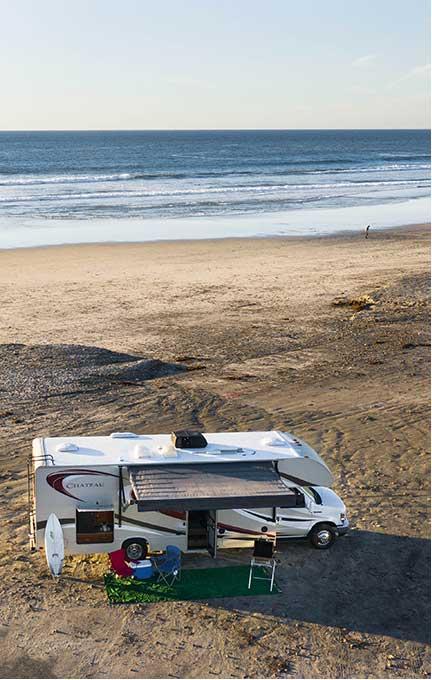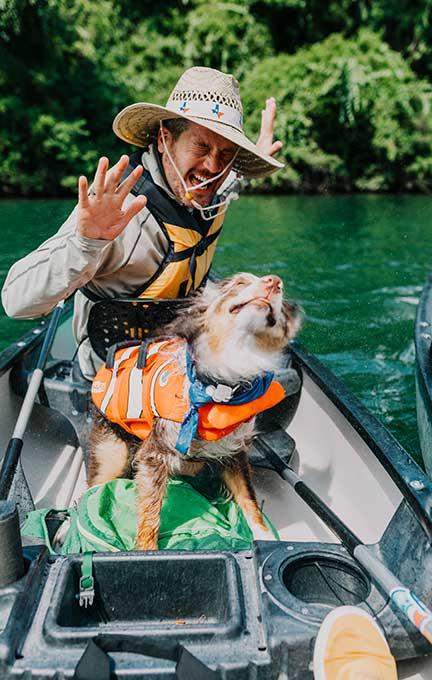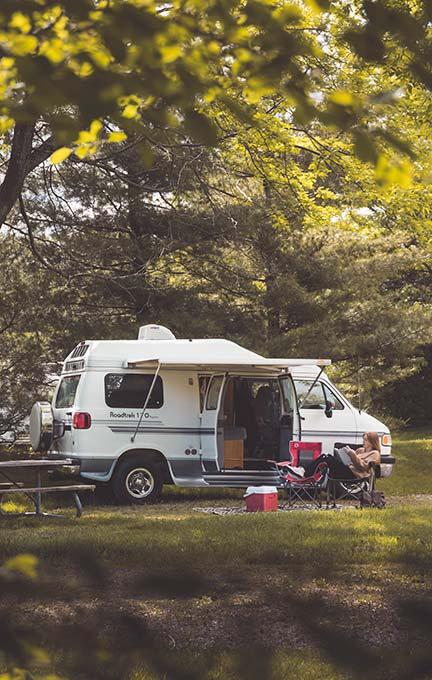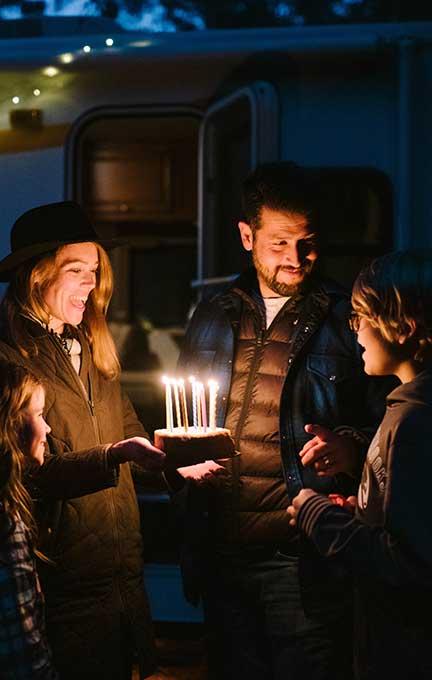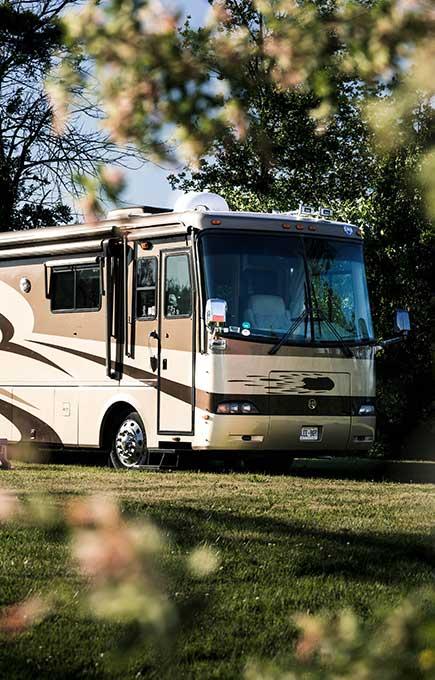Like the National Park Service, the mission of the Bureau of Land Management (BLM) is to “sustain the health, diversity, and productivity of the public lands for the use and enjoyment of present and future generations.”
However, the 245 million (yes, million) acres managed by the BLM include wilderness areas, historic trails, landmarks, and primitive public land, is generally a lot more secluded and offers a welcomed escape from the hustle and bustle of high-traffic recreation areas.
RVs For Rent Near You
But just because BLM land is generally off the beaten path, so to speak, that doesn’t mean it’s completely devoid of rules and regulations. A few things need to be ironed out before boondocking in the backcountry, heading off the grid in your adventure rig, or appreciating the amenities of a developed site on BLM land.

How to Find BLM Land
Check out this book to see all the options for free van camping on Bureau of Land Management (BLM) public lands. The BLM manages one in every 10 acres of land in the United States. So, although most BLM land is located in the Western states, you shouldn’t have to venture too far to find the perfect place to pitch a tent.
One of the easiest ways to find BLM land is by leveraging the interactive maps provided by the Bureau of Land Management. Pick your destination, filter the results based on your favorite outdoor activity, or type in a few keywords to narrow your search.
A quick search for California public land catered to climbing, for example, displays several incredible wilderness areas, national monuments, and campgrounds. A detailed excerpt is provided, as well as an in-depth map, current restrictions, fees, directions, and contact information for the nearest BLM field office.

Developed Campgrounds vs. Dispersed Camping
Not all camping is created equal, especially on BLM land. If you spend enough time sifting through BLM recreation areas, you’ll notice there’s a considerable difference between developed and dispersed camping.
Developed campgrounds will typically offer more frills and facilities than dispersed campsites. So, if you’re looking for a site with filtered water, restrooms, picnic areas, or electrical hookups, you’ll have better luck looking for a developed campground. Developed campgrounds don’t always offer the same amenities, but a quick search on recreation.gov will give you a rundown of campsite features, fees, reservation requirements, and might even feature a few snapshots of your campsite.
Dispersed camping, or “boondocking,” on the other hand, requires a bit more ingenuity and adventure. Believe it or not, there are vast areas of undeveloped public land available to campers. These primitive sites are often free, peaceful, and completely self-sustained. In fact, finding a campsite is half the fun. Websites like freecampsites.net and Campendium are available to help rookie boondockers locate dispersed campgrounds.
However, the Bureau of Land Management allows dispersed camping on most public land, as long as the area isn’t already developed or designated as a ‘no camp zone.’ All they ask is that you do your part to preserve the landscape and leave the campsite better than you found it. You also can’t stay for more than 14 days within a 28 consecutive day period.

Permits and Fees
Each wilderness area or recreation site will have its own fees and permit requirements. The cost and payment methods available will vary depending on the site. While some recreation areas have a visitor center or accept electronic payments, others have a primitive approach and leave envelopes at the trailhead or campsite to deposit cash. We recommend researching the location in advance, so you have cash on hand if you need it. After all, every penny collected by the Bureau of Land Management goes back to the maintenance and preservation of our public land!
Recreation passes, like the America the Beautiful Pass, can be purchased in advance to cover entrance fees or standard amenity fees. However, advanced research on a particular site is still necessary. Additional fees may be required for camping and recreation purposes.
Rules and Regulation
Looking for information on building a fire or what to do if you encounter wildlife? Before traveling to or camping on any public land, read through the safety tips outlined by the Bureau of Land Management.
Once you’re familiar with the basics, you can do your part to preserve and protect these beautiful landscapes by abiding by the following rules and regulations.
When camping in a developed campground:
- Use explicitly marked sites
- Respect other campers by abiding by posted quiet hours
- Read posted fire regulations and keep fires within a designated ring, grill, or stove
- Do not leave personal items unattended
When camping in undeveloped areas:
- Do not camp in designated “no camp zones”
- Stay on designated roadways when traveling in a vehicle
- Try to choose a site that is already established
- Camp at least 200 feet from water sources
- Check current fire regulations and do not build a campfire when there is a risk of wildfire
- Pay close attention to signs to respect native plants and species
- If you pack it in, pack it out
All campers and visitors are asked to tread lightly and follow the seven principles of Leave No Trace.
Staying Safe While Camping on BLM Land
Here’s a list of safety tips for camping on BLM land to help you prepare for a safe and enjoyable experience:
Research the Area Before You Go
- Learn about the terrain, weather conditions, and local wildlife.
- Check for any alerts or restrictions on the BLM website or at the nearest field office.
- Know the rules for camping, including fire regulations and stay limits.
Share Your Plans
- Tell someone your camping location and expected return time.
- Provide them with GPS coordinates or a detailed description of your campsite.
- Carry a satellite communicator or personal locator beacon if you’re camping in a remote area without cell service.
Prepare for Limited Amenities
- Most BLM lands have no water, toilets, or trash facilities. Bring enough water for drinking, cooking, and cleaning (1–2 gallons per person per day).
- Pack out all trash and human waste to protect the environment and avoid fines.
Be Wildlife Aware
- Store food in bear-proof containers or your vehicle to avoid attracting wildlife.
- Never feed wild animals, and stay at least 100 feet away from larger animals like bears or mountain lions.
- Carry bear spray if camping in bear country.
Stay Safe Around Campfires
- Follow local fire regulations and check for fire bans.
- Use a fire pan or existing fire ring to minimize your impact.
- Keep a bucket of water or fire extinguisher nearby, and never leave a fire unattended.
Navigation and Communication
- Bring a detailed map, compass, and GPS device. Don’t rely solely on phone apps, as reception is often unreliable.
- Familiarize yourself with landmarks to avoid getting lost.
Emergency Preparedness
- Pack a first aid kit tailored to the area and your activities.
- Carry extra food, water, and warm clothing in case of unexpected delays.
- Know the location of the nearest hospital or ranger station.
Be Weather-Ready
- Check the forecast before you go, but also prepare for sudden weather changes, especially in desert or mountain regions.
- Avoid camping in dry creek beds or low-lying areas prone to flash floods.
Respect Your Surroundings
- Camp at least 200 feet from water sources to protect wildlife access.
- Use durable surfaces like gravel or hard-packed soil for your campsite to minimize erosion.
- Avoid camping near cliff edges, unstable terrain, or under dead trees.
Stay Hydrated and Protected
- Bring plenty of water, as many BLM areas lack natural water sources.
- Wear sunscreen, a hat, and lightweight protective clothing to avoid sunburn or dehydration, especially in desert areas.
Be Cautious with Off-Road Vehicles
- If you’re using an off-road vehicle to access your site, ensure you stick to designated trails.
- Carry extra fuel, a spare tire, and a repair kit for emergencies.
Be Aware of Local Laws and Hunting Seasons
- Check for hunting season dates in the area and wear bright colors if necessary.
- Respect private property boundaries near BLM land.
By following these tips, you can ensure a safe and enjoyable camping experience while respecting the land and its rules.
What to Pack for Boondocking on BLM Land
When RV boondocking on BLM land, it’s essential to prepare for self-sufficiency since there are usually no hookups, facilities, or services available.
Here’s a comprehensive packing list for RV boondocking on BLM land:
Water and Hydration Supplies
- Fresh Water Tanks: Fill them completely before heading out.
- Portable Water Jugs: For extra drinking water (1–2 gallons per person per day).
- Water Filtration System: If you plan to refill from natural sources.
- Collapsible Water Container: For transporting water if necessary.
Power and Energy
- Solar Panels or Generator: For off-grid power supply.
- Extra Fuel or Propane: For your generator, stove, or water heater.
- Battery Bank: To store extra power for lights, devices, or appliances.
- Inverter: For charging electronics.
Waste Management
- Black and Gray Tank Chemicals: To reduce odors.
- Portable Waste Tote: For emptying tanks if dump stations are unavailable.
- Trash Bags: For all trash and recyclables.
- Compostable Bags or Wag Bags: For emergency toilet use if tanks fill up.
Food and Cooking Supplies
- Non-Perishable Food: Canned goods, pasta, rice, freeze-dried meals, and snacks.
- Refrigerated/Frozen Food: Maximize storage in your RV fridge/freezer.
- Cooking Fuel: Propane or other fuels for stoves and grills.
- Portable Grill or Camp Stove: For outdoor cooking.
- Utensils, Plates, and Cookware: Lightweight, reusable, and RV-friendly.
- Cooler and Ice Packs: For extra food storage if needed.
- Water for Cooking and Cleaning: Bring extra for dishwashing.
Navigation and Communication
- Offline Maps or GPS Device: BLM areas often lack cell service.
- Paper Maps: As a backup.
- Two-Way Radio or Satellite Communicator: For emergencies.
- Cell Phone Booster: To improve signal in remote areas.
Safety and First Aid
- First Aid Kit: Fully stocked and tailored for the area.
- Fire Extinguisher: Ensure it’s in good condition.
- Bear Spray: If camping in bear country.
- Flashlights, Headlamps, and Lanterns: With extra batteries.
- Tool Kit: For RV repairs (wrenches, screwdrivers, duct tape, etc.).
- Tire Repair Kit and Air Compressor: For emergency tire fixes.
- Emergency Roadside Kit: Includes flares, jumper cables, and a jack.
- Whistle or Air Horn: For signaling in emergencies.
RV Comfort and Maintenance Supplies
- Leveling Blocks: To park your RV on uneven ground.
- Spare RV Parts: Fuses, hoses, connectors, and filters.
- Portable Heater or Fans: Depending on the season.
- Extra Blankets and Bedding: For colder nights.
- Cleaning Supplies: Broom, dustpan, multi-surface cleaner, and wipes.
Outdoor and Recreation Gear
- Camp Chairs and Table: For relaxing outside.
- Hiking Gear: Boots, backpack, and trekking poles.
- Binoculars: For stargazing or wildlife watching.
- Portable Fire Pit or Fire Pan: If fires are allowed.
- Games or Books: For entertainment.
Personal Essentials
- Clothing: Layers for varying temperatures, including rain gear.
- Hats and Sunglasses: For sun protection.
- Sunscreen and Bug Spray: For UV and insect protection.
- Hygiene Items: Biodegradable soap, towels, toothbrush, toothpaste, and hand sanitizer.
- Toilet Paper and Wipes: RV-friendly and eco-friendly options.
Leave No Trace Supplies
- Trash Bags and Ziplocks: To pack out all waste.
- Broom and Dustpan: To leave your site clean.
- Trowel: For digging catholes if necessary.
Documents and Permits
- RV Registration and Insurance Papers: Keep them accessible.
- Permits: Check if you need a permit for camping in certain BLM areas.
- BLM Maps and Area Guides: Print or download before arriving.
By packing these essentials, you’ll be prepared for a safe, enjoyable, and eco-friendly RV boondocking experience on BLM land. Adjust based on the specific location, season, and duration of your trip.
Can I have a campfire while boondocking?
Campfires are generally allowed but are subject to local fire restrictions, especially during dry seasons. Use existing fire rings, keep fires small, and fully extinguish them before leaving. A portable fire pit may be required in some areas.
How do I handle waste and trash?
- Dump black and gray tanks at approved dump stations before leaving.
- Pack out all trash, including food scraps and paper products.
- Use eco-friendly RV tank chemicals to minimize odors.
How do I stay connected while boondocking?
- Use a cell phone signal booster, such as a WeBoost.
- Bring a satellite communicator for emergencies in areas without cell service.
- Download offline maps and guides before arriving.
Can I bring pets while boondocking?
Yes, pets are allowed on most BLM land. Keep them leashed, supervise them at all times, and clean up after them. Watch for hazards like snakes, coyotes, or extreme temperatures.
What are the Leave No Trace principles for RV boondocking?
- Plan Ahead: Know the rules for your site.
- Camp on Durable Surfaces: Avoid fragile vegetation.
- Dispose of Waste Properly: Pack it in, pack it out.
- Minimize Campfire Impact: Use fire pans or existing rings.
- Respect Wildlife: Keep a safe distance and store food securely.
Can I use an ATV or off-road vehicle on BLM land?
Off-road vehicles are allowed in designated areas. Check local rules and stick to marked trails to protect the land.
Are there quiet hours on BLM land?
While there are no formal quiet hours in dispersed camping areas, be considerate of other campers. Keep noise, including generator use, to a minimum during nighttime hours.
By preparing ahead and respecting the land, you can enjoy a safe and rewarding RV boondocking experience on BLM land.
Conclusion
From Alaska’s arctic tundra to vast spans of the desert in Arizona and public river islands of Wisconsin, America ’s BLM land contains some of the nation’s most spectacular landscapes. With millions of acres to explore, you’re guaranteed to find your slice of paradise on or off the beaten path.




